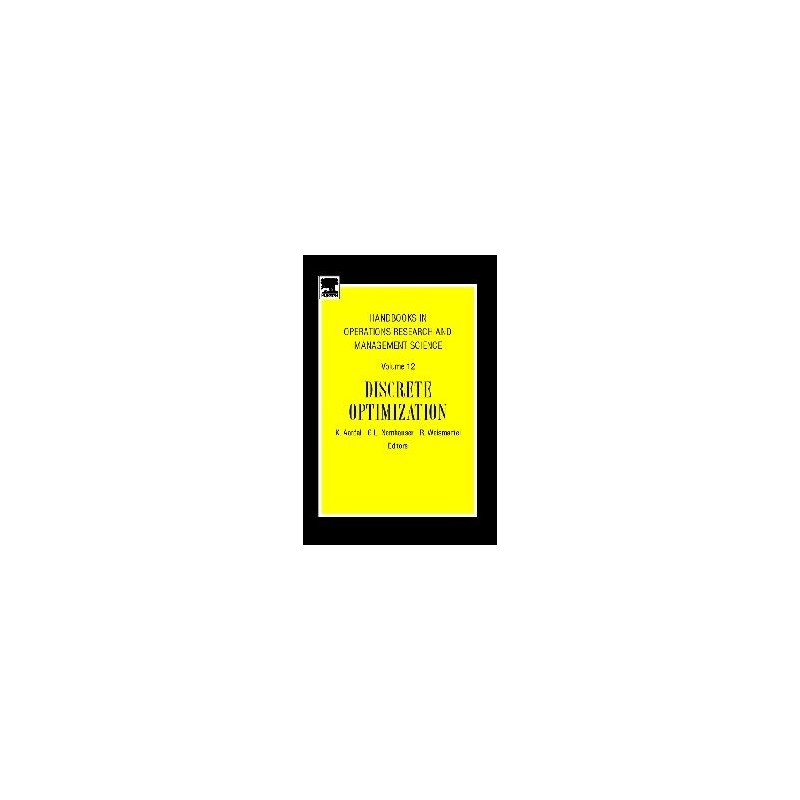- Obecnie brak na stanie



The handbook will be a useful reference to experts in the field as well as students and others who want to learn about discrete optimization.
All of the chapters in this handbook are written by authors who have made significant original contributions to their topics. Herewith a brief introduction to the chapters of the handbook.
"On the history of combinatorial optimization (until 1960)" goes back to work of Monge in the 18th century on the assignment problem and presents six problem areas: assignment, transportation,
maximum flow, shortest tree, shortest path and traveling salesman.
The branch-and-cut algorithm of integer programming is the computational workhorse of discrete optimization. It provides the tools that have been implemented in commercial software such as CPLEX
and Xpress MP that make it possible to solve practical problems in supply chain, manufacturing, telecommunications and many other areas.
"Computational integer programming and cutting planes" presents the key ingredients
of these algorithms.
Although branch-and-cut based on linear programming relaxation is the most widely used integer programming algorithm, other approaches are
needed to solve instances for which branch-and-cut performs poorly and to understand better the structure of integral polyhedra. The next three chapters discuss alternative approaches.
"The structure of group relaxations" studies a family of polyhedra obtained by dropping certain
nonnegativity restrictions on integer programming problems.
Although integer programming is NP-hard in general, it is polynomially solvable in fixed dimension. "Integer programming, lattices, and results in fixed dimension" presents results in this area including algorithms that use reduced bases of integer lattices that are capable of solving certain classes of integer programs that defy solution by branch-and-cut.
Relaxation or dual methods, such as cutting plane algorithms,progressively remove infeasibility while maintaining optimality to the relaxed problem. Such algorithms have the disadvantage of
possibly obtaining feasibility only when the algorithm terminates.Primal methods for integer programs, which move from a feasible solution to a better feasible solution, were studied in the 1960's
but did not appear to be competitive with dual methods. However,recent development in primal methods presented in "Primal integer programming" indicate that this approach is not just interesting theoretically but may have practical implications as well.
The study of matrices that yield integral polyhedra has a long tradition in integer programming. A major breakthrough occurred in the 1990's with the development of polyhedral and structural results
and recognition algorithms for balanced matrices. "Balanced matrices" is a tutorial on the
subject.
Submodular function minimization generalizes some linear combinatorial optimization problems such as minimum cut and is one of the fundamental problems of the field that is solvable in polynomial
time. "Submodular function minimization" presents the theory and algorithms of this subject.
In the search for tighter relaxations of combinatorial optimization problems, semidefinite programming provides a generalization of
linear programming that can give better approximations and is still polynomially solvable. This subject is discussed in "Semidefinite programming and integer programming".
Many real world problems have uncertain data that is known only probabilistically. Stochastic programming treats this topic, but until recently it was limited, for computational reasons, to
stochastic linear programs. Stochastic integer programming is now a high profile research area and recent developments are presented in
"Algorithms for stochastic mixed-integer programming
models".
Resource constrained scheduling is an example of a class of combinatorial optimization problems that is not naturally formulated with linear constraints so that linear programming based methods do
not work well. "Constraint programming" presents an alternative enumerative approach that is complementary to branch-and-cut. Constraint programming,primarily designed for feasibility problems, does not use a relaxation to obtain bounds. Instead nodes of the search tree are
pruned by constraint propagation, which tightens bounds on variables until their values are fixed or their domains are shown to be empty.
1. On the History of Combinatorial Optimization (till 1960) (A. Schrijver). 2. Computational Integer Programming and Cutting Planes (A. Fügenschuh, A. Martin). 3. The Structure of Group Relaxations (R. R. Thomas). 4. Integer programming, lattices, and results in fixed dimension (K. Aardal, F. Eisenbrand). 5. Primal Integer Programming (B. Spille, R. Weismantel). 6. Balanced Matrices (G. Cornuéjols, M. Conforti). 7. Submodular Function Minimization (T. McCormick). 8. Semidefinite Programming and Integer Programming (M. Laurent, F. Rendl). 9. Algorithms for Stochastic Mixed-Integer Programming Models (S. Sen). 10. Constraint Programming (A. Bockmayr, J.N. Hooker).
Płytka drukowana i zaprogramowany układ do sterownika silnika DC do napędu. AVT5565 A+
Brak towaru
Zestaw pozwala na wprowadzenie w tematykę pomiarów odległości, oświetlenia w otoczeniu i analizy gestów przy pomocy czujnika VL6180X. Płytka NUCLEO-F401RE w zestawie z płytką rozszerzającą VL6180X. P-NUCLEO-6180X1
Brak towaru
Moduł kamery z sensorem IMX519 dedykowany do minikomputerów Raspberry Pi. Wykorzystuje matrycę 16 MP i pozwala na nagrywanie wideo w rozdzielczościach 1080p@30fps. Waveshare IMX519-78 16MP AF Camera
Brak towaru
Minikomputer z ośmiordzeniowym procesorem (do 1,4GHz) i 1 GB pamięci DDR3 RAM, 8 GB pamięci Flash eMMC. Posiada moduł WiFi 2.4G oraz interfejsy video w postaci HDMI, a także USB2.0, MicroSD, port Ethernet i gniazdo audio 3,5 mm. FriendlyELEC NanoPC T3
Brak towaru
Przewód audio z wtykami minijack 3,5 mm 3-pin o długości 1,2 m. GEMBIRD CCA-404
Brak towaru
ZESTAW DO WYKONYWANIA PŁYTEK DRUKOWANYCH.
Brak towaru
Brak towaru
Komputer SBC z SoC Allwinner H8 (8-rdzeniowy Cortex-A7 2 GHz, PowerVR SGX544MP) wyposażony m.in. w pamięć RAM 2 GB, pamięć eMMC 8 GB, WiFi a/b/g/n, Bluetooth, interfejs SATA 2.0
Brak towaru
ZL9ARM - płytka bazowa dla modułów dipARM z mikrokontrolerami LPC213x i LPC214x
Brak towaru
ARM7TDMI, 256kB Flash (ISP), 32kB RAM, USB 2.0, ADC, DAC, 2xUART, 2xI2C, SPI, LQFP64, RoHS
Brak towaru
Brak towaru
Brak towaru
Zestaw AVT do samodzielnego montażu karte przekaźników programowanej sekwencjami. AVT1998 B
Brak towaru
Brak towaru
Brak towaru
Brak towaru

